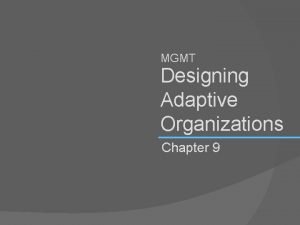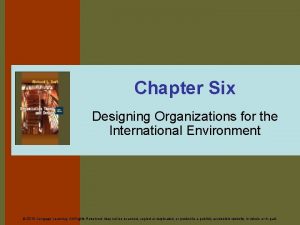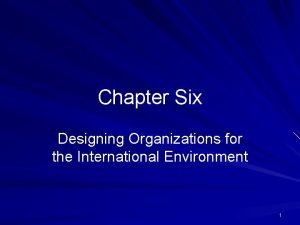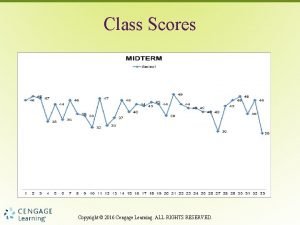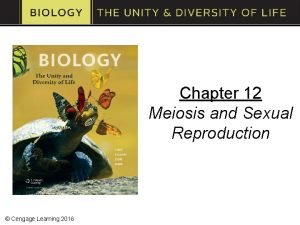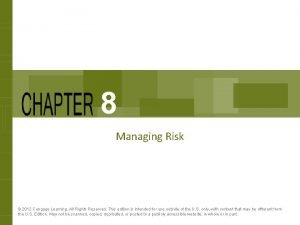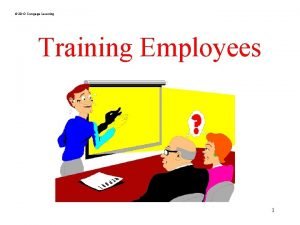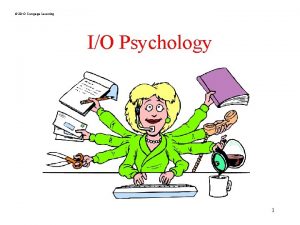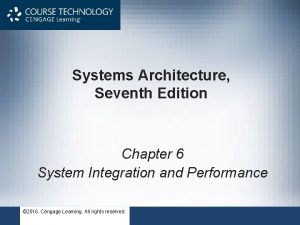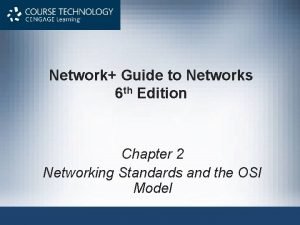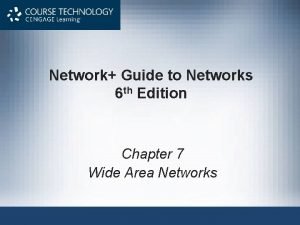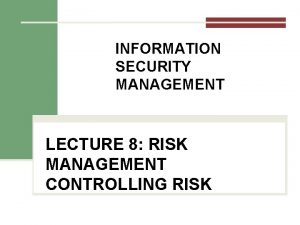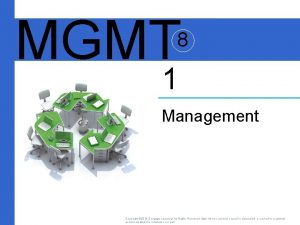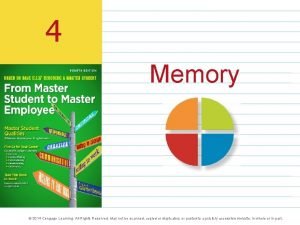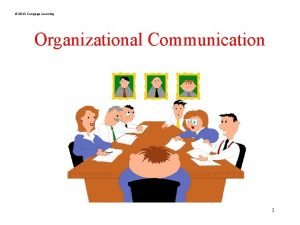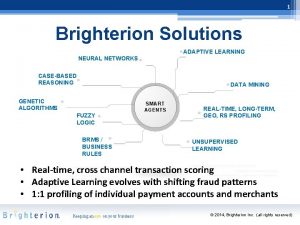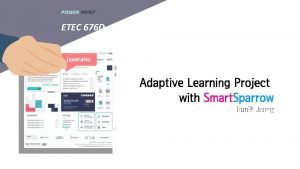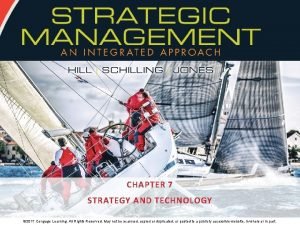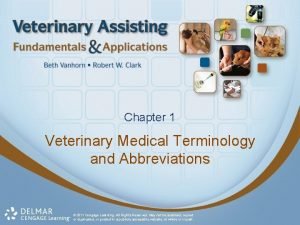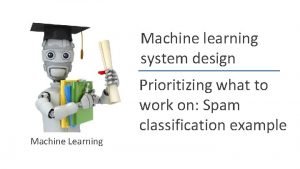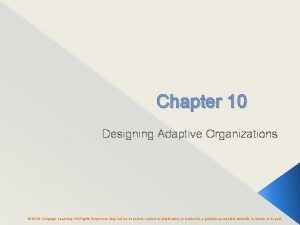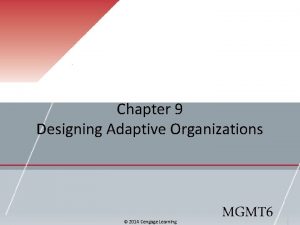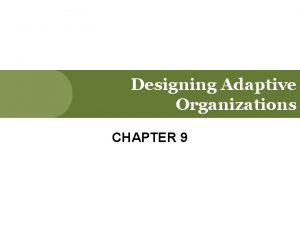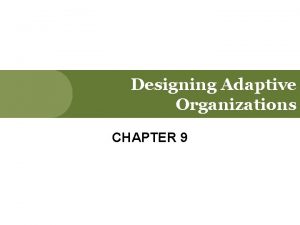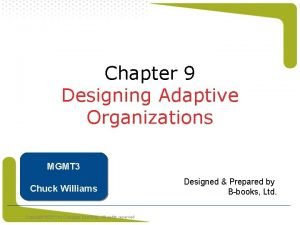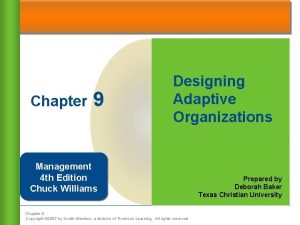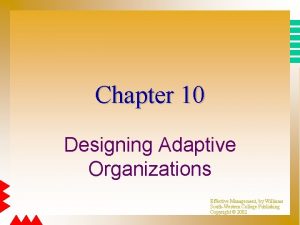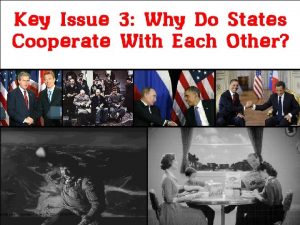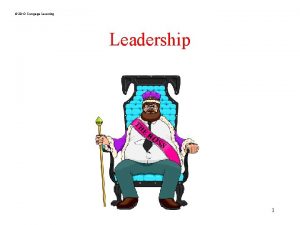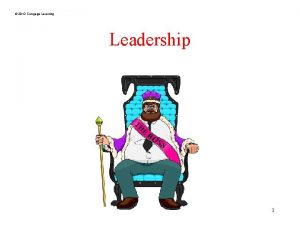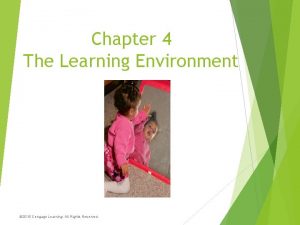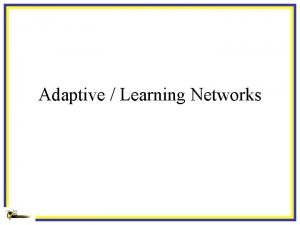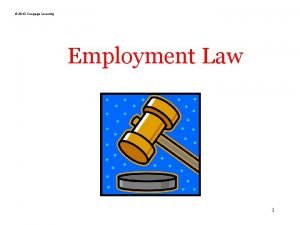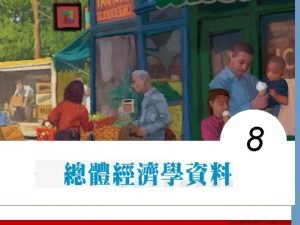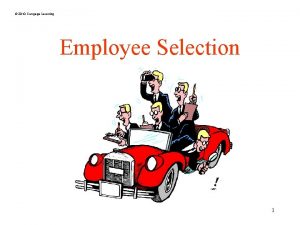Chapter 9 Designing Adaptive Organizations 2015 Cengage Learning





















































- Slides: 53

Chapter 9 Designing Adaptive Organizations © 2015 Cengage Learning MGMT 7

Structure and Process • Organizational structure • Organizational process © 2015 Cengage Learning

Organizational Structure • Organizational Structure – The vertical and horizontal configuration of departments, authority, and jobs within a company. • Is concerned with questions such as, ”Who reports to whom? ” and “Who does what? ” and “Where is the work done? ”. 4 Copyright © 2008 Cengage Learning. All rights reserved

Thomson Reuters © 2015 Cengage Learning

Organization Chart 6 Copyright © 2008 Cengage Learning. All rights reserved

7 Copyright © 2008 Cengage Learning. All rights reserved

8 Copyright © 2008 Cengage Learning. All rights reserved

Process View of Microsoft’s Organization © 2015 Cengage Learning

Organizational Process • Organizational Process – The collection of activities that transform inputs into outputs that customers value. – Organizational process asks: “How do things get done? ” 10

Departmentalization • Functional • Product • Customer • Geographic • Matrix © 2015 Cengage Learning 9 -1

Departmentalization • Functional Departmentalization – Organizes work and workers into separate units responsible for particular business functions or areas of expertise. A common functional structure might have individuals organized into accounting, sales, marketing, production, and human resources department. 12

Functional Departmentalization © 2015 Cengage Learning 9 -1

Functional Departmentalization • Advantages – allows work done by highly qualified specialists – lowers costs by reducing duplication – makes communication and coordination easier • Disadvantages – cross-department coordination can be difficult – may lead to slower decision making 9 -1 © 2015 Cengage Learning

Departmentalization • Product Departmentalization – Organizes work and workers into separate units responsible for producing particular products or services. 15

Departmentalization • Customer departmentalization – Organizes work and workers into separate units responsible for particular kinds of customers. 16

Product Departmentalization: UTC © 2015 Cengage Learning 9 -1

Product Departmentalization • Advantages – allows people to specialize in one area of expertise – makes it easier to assess performance – makes decision making faster • Disadvantages – duplication – coordination across different product departments 9 -1 © 2015 Cengage Learning

Customer Departmentalization: Swisscom AG © 2015 Cengage Learning 9 -1

Customer Departmentalization • Advantages – focuses organization on customer needs – allows companies to specialize products and services to customer needs • Disadvantages – duplication of resources – workers might please customers but hurt business © 2015 Cengage Learning 9 -1

Departmentalization • Geographic departmentalization – Organizes work and workers into separate units responsible for doing business in particular geographic areas. 21

Coca-Cola Enterprises Territories of Operation Geographic Departmentalization 22

Geographic Departmentalization • Advantages – helps companies respond to different markets – reduces costs by locating unique resources closer to customers • Disadvantages – duplication of resources – difficult to coordinate departments © 2015 Cengage Learning 9 -1

Departmentalization • Matrix Departmentalization – A hybrid structure in which two or more forms of departmentalization are used together. – The most common matrix combines the product and functional forms of departmentalization, but other forms might be used. 25

Matrix Departmentalization: Procter & Gamble © 2015 Cengage Learning 9 -1

Matrix Departmentalization • Advantages – allows companies to efficiently manage large, complex tasks – gives much more diverse set of expertise and experience • Disadvantages – requires a high level of duplication – confusion and conflict between project bosses – requires much more management skill © 2015 Cengage Learning 9 -1

Chain of Command • Chain of command – The vertical line of authority in an organization. – Clarifies who reports to whom. • Unity of command – Workers report to only one boss. – Matrix organizations violate this principle. 9 -2 © 2015 Cengage Learning

Authority • Line authority – the right to command immediate subordinates in the chain of command • Staff authority – the right to advise but not command others • Line function – activity that contributes directly to creating or selling the company’s products • Staff function – does not contribute directly to creating or selling the company’s products, but instead supports line activities. ` 9 -2 © 2015 Cengage Learning

General Staff Incident Commander Public Information Officer Command Staff Liaison Officer Safety Officer Operations Section Planning Section Copyright © 2008 Cengage Learning. All rights reserved Logistics Section Finance/Admin Section General Staff

Delegation of Authority The assignment of direct authority and responsibility to a subordinate to complete tasks for which the manager is normally responsible. 31

Delegation © 2015 Cengage Learning 9 -2

Authority Versus Power: Power 33

How to be a More Effective Delegator 1. 2. 3. 4. 5. 6. 7. 8. 9. Trust your staff to be a good job Avoid seeing perfection Give effective job instructions Know your true interests Follow up on progress. Praise the efforts of your staff. Don’t wait to the last minute to delegate. Ask questions, expect answers, assist employees. Provide the resources you would provide if doing the assignment yourself. 10. Delegate to the lowest possible level. 34 Copyright © 2008 Cengage Learning. All rights reserved

Degree of Centralization • Centralization of authority – primary authority is held by upper management • Decentralization – significant authority is found in lower levels of the organization • Standardization – solving problems by applying rules, procedures, and processes © 2015 Cengage Learning 9 -2

Advantages of Decentralization • Develops employee capabilities • Faster decision making • More satisfied employees and customers • Better employee performance © 2015 Cengage Learning 9 -2

Job Design • Specialized Jobs • Job Rotation, Enlargement, Enrichment • Job Characteristics Model

Job Specialization • Job comprises a smaller part of a larger task • Jobs are simple, easy to learn • Low variety, high repetition • Can lead to low satisfaction, high absenteeism, and employee turnover © 2015 Cengage Learning 9 -3

Job Rotation, Enlargement, Enrichment • Rotation – periodically moving workers from one specialized job to another. • Enlargement – increasing the number of tasks performed by a worker • Enrichment – adding more tasks and authority to an employee’s job © 2015 Cengage Learning 9 -3

Job Characteristics Model § A job redesign approach that seeks to increase employee motivation § Factors that increase internal motivation § experience work as meaningful § experience responsibility for work outcomes § knowledge of results 40

Job Characteristics Model © 2015 Cengage Learning 9 -3

Core Job Characteristics • Skill variety – The number of different activities performed in a job. • Task identity – The degree to which a job, from beginning to end, requires completion of a whole and identifiable piece of work. • Task significance – The degree to which a job is perceived to have a substantial impact on others inside or outside the organization. • Autonomy – The degree to which a job gives workers the discretion, freedom and independence to decide how and when to accomplish the work. • Feedback – The amount of information the job provides to workers about their work performance. © 2015 Cengage Learning 9 -3

To Increase Internal Motivation • Combine tasks • Form natural work units • Establish client relationships • Vertical loading • Open feedback channels 9 -3 © 2015 Cengage Learning

Intraorganizational Processes The collection of activities that take place within an organization to transform inputs into outputs that customers value. 9 -4 © 2015 Cengage Learning

Designing Organizational Processes • Mechanistic organization – Characterized by specialized job and responsibilities; precisely defined unchanging roles, and a rigid chain of command based on centralized authority and vertical communication. • Organic organization – Characterized by broadly defined jobs and responsibility; loosely defined, frequently changing roles, and decentralized authority and horizontal communication. 46

Reengineering “the fundamental rethinking and radical redesign of business processes to achieve dramatic improvements in critical, contemporary measures of performance, such as cost, quality, service and speed. ” 9 -4 © 2015 Cengage Learning

Reengineering § Managers must ask themselves § Why do we do what we do? § Why do we do it the way we do? § Reengineering changes work by changing task interdependence, the extent to which collective action is required to complete an entire piece of work.

Reengineering and Task Interdependence 50

Reengineering and Task Interdependence • Reengineering is about achieving quantum improvements in company performance. • Reengineering changes an organization’s orientation from vertical to horizontal. • Instead of taking orders from upper management, lower- and middle-level managers and workers take orders from a customer who is at the beginning and end of each process. Instead of running independent functional departments, managers and workers in different departments take ownership of cross-functional processes. • Instead of simplifying work so that it becomes increasingly specialized, reengineering complicates work by giving workers increased autonomy and responsibility for complete processes.

Empowerment • Empowering workers – permanently passing decision-making authority and responsibility from managers to workers. • Empowerment – a feeling of intrinsic motivation, in which workers perceive their work to have meaning and perceive themselves to be competent, having an impact, and capable of self-determination © 2015 Cengage Learning 9 -4

Interorganizational Processes A collection of activities that occur among companies to transform inputs into outputs that customers value. © 2015 Cengage Learning 9 -5

Modular Organization © 2015 Cengage Learning 9 -5

Modular Organizations • Modular organizations outsource all remaining business activities to outside companies, suppliers, specialists, or consultants. – Advantages • reduced costs – Disadvantages • loss of control • noncore business activities that are outsourced may become a source of competitive advantage • suppliers to whom work is outsourced can become competitors 9 -5 © 2015 Cengage Learning

Virtual Organizations • A virtual organization is part of a network in which many companies share skills, costs, capabilities, markets, and customers with each other. – Advantages • shared costs • fast and flexible – Disadvantages • difficult to control quality of work done by partners • requires tremendous managerial skills © 2015 Cengage Learning 9 -5

Modern Shed <click screenshot for video> 1. Describe how Modern Shed functions as a modular organization. 2. What are the advantages and disadvantages of Modern Shed’s organizational structure? © 2015 Cengage Learning
 Matrix departmentalization
Matrix departmentalization Designing adaptive organizations
Designing adaptive organizations Designing organizations for the international environment
Designing organizations for the international environment Designing organization for international environment
Designing organization for international environment Chapter 13 medical math assignment sheet
Chapter 13 medical math assignment sheet Cengage learning chapter 7 answers
Cengage learning chapter 7 answers Delmar cengage learning medical terminology
Delmar cengage learning medical terminology Chapter 5 the cardiovascular system
Chapter 5 the cardiovascular system Cengage learning heart diagram
Cengage learning heart diagram South-western cengage learning
South-western cengage learning 2009 delmar cengage learning
2009 delmar cengage learning Cengage learning heart diagram
Cengage learning heart diagram 1/52 medical terminology
1/52 medical terminology Cengage learning australia
Cengage learning australia Measuring and recording apical pulse
Measuring and recording apical pulse Cengage learning
Cengage learning Cengage learning
Cengage learning Wadsworth cengage learning
Wadsworth cengage learning Cengage learning
Cengage learning Cengage learning plant cell
Cengage learning plant cell Cengage learning
Cengage learning Cengage learning
Cengage learning Brooks cole cengage learning
Brooks cole cengage learning 2014 cengage learning accounting answers
2014 cengage learning accounting answers Copyright cengage learning. powered by cognero
Copyright cengage learning. powered by cognero Cengage learning
Cengage learning Cengage learning
Cengage learning 2009 delmar cengage learning
2009 delmar cengage learning Cengage learning
Cengage learning 2009 delmar cengage learning
2009 delmar cengage learning Consumer behavior cengage
Consumer behavior cengage 2012 cengage learning
2012 cengage learning Cengage learning 2013
Cengage learning 2013 Cengage learning psychology
Cengage learning psychology Course technology cengage learning
Course technology cengage learning Course technology cengage learning
Course technology cengage learning Course technology cengage learning
Course technology cengage learning Course technology cengage learning
Course technology cengage learning Mgmt+8
Mgmt+8 Delmar cengage learning instructor resources
Delmar cengage learning instructor resources 2014 cengage learning
2014 cengage learning 2010 cengage learning
2010 cengage learning Adaptive learning neural network
Adaptive learning neural network Adaptive learning ppt
Adaptive learning ppt Cengage chapter 7
Cengage chapter 7 Chapter 13 accounting
Chapter 13 accounting Cengage chapter 8 answers
Cengage chapter 8 answers Alges root word
Alges root word Cengage chapter 4 answers
Cengage chapter 4 answers Prescription terms
Prescription terms Cuadro comparativo de e-learning
Cuadro comparativo de e-learning Ros smith
Ros smith Jonassen constructivist learning environment
Jonassen constructivist learning environment Designing machine learning systems
Designing machine learning systems
